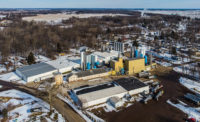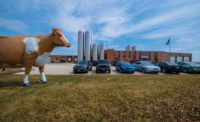Employees at Associated Milk Producers Inc.’s (AMPI) Sanborn, Iowa, plant might be seeing double, but that doesn’t mean there’s anything wrong with their vision. Instead, it’s a reflection of a recent expansion that doubled the facility’s cheesemaking capacity.
During the expansion project, the plant — which became part of New Ulm, Minn.-based AMPI when operator O’Brien County Co-op Creamery joined the cooperative in 1970 — received upgrades that include eight new cheese vats, increased automation and enhancements to the whey processing and storage area.
During Dairy Foods’ visit, the plant’s cheesemaking operations were still mainly dedicated to its award-winning cheddar (albeit more of it). But Harold Peters, division manager of the Sanborn and Freeman, S.D., facilities, said the facility was in the process of tweaking recipes and operations in anticipation of producing Monterey Jack, colby, marble jack and other natural cheeses very soon.
The plant aims to produce roughly 150,000 pounds a day of those new cheeses, along with an equal amount of cheddar. The 68,000-square-foot plant can process 3 million pounds of milk daily at capacity, Peters said, with most of that milk being sourced from farmer-owners located within 100 miles of the facility.
“Much planning went into the design of the plant,” said Mike Wolkow, AMPI’s senior vice president of operations. “There are aspects of the building that will accommodate future modifications and growth.”
New vats greet fresh milk
The cheesemaking process starts with fresh milk being delivered from owner farms. Delivery is a seven-day/round-the-clock operation, Peters noted, as are plant operations — 109 employees are split between two 12-hour shifts.
The milk then enters the intake area, where it is tested for antibiotics, temperature and more before entering the brand-new pasteurization room, he said. The former pasteurization room is now the salting room.
From there, the milk is homogenized, separated and standardized for the recipe. With the expansion, the plant doubled its milk processing capabilities from 75,000 pounds an hour to 150,000, Peters noted.
Next, the milk is pumped into the new 60,000-pound cheese vats. Each vat requires approximately 24 minutes to fill, he explained. One operator watches all eight vats, with each vat typically being in a different stage of the cheesemaking process.
“The new state-of-the-art cheese vats have increased yield and efficiencies,” Peters pointed out. “Automation allows the same number of employees to produce twice as much cheese.”
Once a vat is filled, the appropriate color, cultures and coagulant are added, Peters said. The make process follows — the American cheese varieties the facility produces all require approximately two hours for this step.
During the make process, some of the whey drains out in the vats. After the make process is complete, the cheese is pumped out of the tank onto the DMC (draining-matting-cheddaring) conveyor — essentially a wedge-wire screen, where more of the whey is drained off. The DMC can handle three vats at a time and requires 80 minutes to drain, Peters said.
Away with more whey
The curd product collects at the bottom and is conveyed onto a belt to the salter, where it undergoes salting and stirring. After 30 minutes, the nearly finished cheese is transferred to the packaging area, Peters explained, where it is packaged first in 640-pound boxed blocks. Each block rests for a while, then enough cheese is added to take the weight up to 700 pounds.
Because the cheese still contains some salt whey, the plant relies on five sets of vacuum probes to suck most of the remainder out. A prepress is then used to keep the cheese block intact. Operators pull a sample from each block before placing a board atop the block and sending the block through the churn press.
In the churn press, the block is laid on its side to drain for about an hour. Operators then use an air cylinder to move each block into the vacuum chamber, which removes even more of the whey, along with excess air, Peters said. Operators then remove the board, push the cheese down, spray the top of the block with a preservative and top the block with a liner. Each block is clamped down before being conveyed out of the packaging area into the cooler.
The blocks are held in the cooler for five days. A quality assurance technician then examines each one before pulling a plug to taste it and grade it.
Once they pass inspection and testing, the boxed blocks are shipped to a cooler for additional holding before customer pickup. The customers then return the boxes to the box supplier.
The Sanborn facility produces approximately 400 of the 640-pound blocks a day, Peters noted.
Sustainability a priority
In a separate operation, meanwhile, the drained whey enters the whey silo. From there, it goes to one of four whey separators (one dedicated to salt whey), Peters said. A membrane system was installed to fractionate whey proteins this past spring.
Most notable on the whey side of the expansion is a new water-polishing system that relies on ultraviolet light and reverse osmosis to provide category 1 water.
“The water can then be reused in the plant for anything,” Peters said. “It’s part of our sustainability initiative.”
Speaking of sustainability, the facility is working with the city of Sanborn and the Iowa Department of Natural Resources to ensure adequate treatment of wastewater originating in other areas of the plant. It also is looking into reuse opportunities for the wastewater, Peters said — for example, potentially using the first-rinse water, which contains approximately 8-10% dairy solids, for animal feed.
Other sustainability efforts include milk swaps to reduce distances the milk travels, an effort to design equipment to minimize food waste, installation of automated valves, installation of LED lighting, an investment to exchange heat between hot and cold products, and the use of super-tankers for off-farm milk hauling and condensed whey, he added.
Emphasis on safety
Employee safety and food safety are just as important as — if not more important than — making award-winning cheese, of course. So the Sanborn facility has robust programs in place to optimize both.
On the food safety side, plant equipment undergoes a thorough cleaning for four hours out of every day, Peters said. The process incorporates robust environmental testing equipment, as well as organoleptic testing.
In addition, the plant is SQF certified, and its employees are trained on good manufacturing practices. Inspections are performed both before and during processing operations.
A quality assurance technician is on hand, too, for every shift, testing all product for pH, moisture, salt levels and more in the in-house lab before releasing it for shipment. Every vat of cheese is tested and graded to ensure food safety and customer satisfaction.
AMPI also has a rigorous supplier certification in place to ensure compliance with the Food Safety Modernization Act (FSMA). The Sanborn facility relies on third-party audits, certificates of analysis and a grading scale to uphold safety and quality on the supplier side.
And when it comes to employees, the plant relies on a number of programs to augment what’s called for under SQF and FSMA. Those include safety-related training during orientation and onboarding, computer-based safety training, forklift training and lockout training, Peters said. Personal protective equipment also is a must on the plant floor.
“We use managers and corporate safety coordinators to do on-site training,” Peters explained, noting that these personnel attend off-site conferences before doing so. “The corporate safety manager regularly publishes a five-minute safety message, ‘Toolbox Talk.’”
Ready for what’s next
The recent expansion isn’t the end of the line in terms of improvements to the Sanborn facility.
“AMPI will continue to invest capital in the plant on projects that improve quality and efficiency,” Wolkow said.
Right now, additional capacity for the finished product cooler, further automation for cheese packaging and expanded capacity for drying ingredients are on the plant’s capital planning list, Peters noted.
To learn about the latest equipment, company and plant personnel maintain strong relationships with equipment suppliers and attend trade shows showcasing such equipment, Wolkow said. Involvement with the Center for Dairy Research at the University of Wisconsin, South Dakota State University and other academic institutions, as well as engagement in regular staff training and seminars, also helps them stay current on industry trends.
But labor challenges remain top of mind as the plant grows. The goal is to make each new employee feel comfortable, so shift supervisors make it a point to check in with him or her often, Peters added.
And AMPI as a whole prides itself on providing opportunities for those employees who do wish to grow in their careers, Wolkow pointed out.
“What each employee wants from their career varies, so we like to be able to provide the experiences and opportunities they can pursue,” he said.
The plant also boasts many long-term employees with a high level of cheesemaking expertise. In fact, the facility earned first-place honors in the Mild Cheddar Category three years in a row at the World Dairy Expo’s Championship Dairy Product contest.
“The AMPI Sanborn plant went from being one of the smallest cheese plants in the co-op’s network of plants to now being one of the biggest. Quality milk and skilled employees have been key to achieving the award-winning cheese AMPI Sanborn has been recognized for throughout the years,” Wolkow emphasized.











